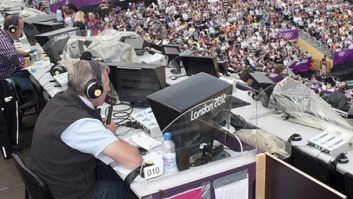A recently published book, edited by Wolfgang Hoeg and Thomas Lauterbach, provides a much-needed primer for the digital modulation of radio. Released for publication in the United States in March, “Digital Audio Broadcasting – Principles and Applications” offers many answers regarding how digital radio modulation works.
The main focus of the book is the Eureka-147 version of DAB, currently in operation in Europe, Canada, Australia, Singapore, China and South Africa, and under development in other Asian nations including India.
The in-band, on-channel form of digital radio, now in research and development in the United States, is mentioned briefly.
Many of the explanations in subsequent chapters have practical applications to IBOC, Digital Radio Mondiale and Integrated Services Digital Broadcasting, the Japanese version of digital radio, as well as Eureka-147.
Essentials
The system concept chapter provides ample descriptions of the frame structure of DAB, interleaving and Differential Quadrature Phase Shift Keying, or DQPSK, all of which have applications in DAB formats other than Eureka-147.
The chapter on audio services and applications provides an understandable description of audio masking techniques and the psychoacoustics of human hearing with their application to bit-rate reduction in digital radio.
The characteristics of MPEG algorithms are provided. Of particular interest is the description of error protection and concealment. The Eureka-147 version of DAB provides for an “ensemble” of audio and ancillary service in the 1.537 MHz of bandwidth of a DAB channel in this scheme. This concept is introduced in the audio services and applications chapter and is described in detail in the following chapter.
The chapter concerning data services and applications tells the story of Eureka-147’s ability to provide ancillary services in terms of multimedia transmission. These include HTML pages, JPEG pictures or slideshows and MPEG movies using the MOT, Multimedia Object Transfer protocol. Eureka-147 is definitely not radio as we once knew it, and Hoeg and Lauterbach’s book definitely prepares us for this new and exciting technology.
A chapter titled “Provision of Services” provides a detailed description of DAB main services – audio services, program associated data (PAD) and packet mode data – data services such as the dynamic label format, MOT protocol and slide shows – broadcast operating systems and editorial systems with the management of text and service data.
This chapter also speaks of the compatibility of digital audio broadcasting with the Radio Data System (RDS/RBDS) and outlines the differences and similarities between DAB and RDS. It closes with a discussion of audio services aspects concerning loudness differences within audio services, DAB/FM switching and DAB ensembles, signal level alignment, metering and control.
Technical details
“Collection and Distribution Networks” provides block diagrams of the DAB ensemble multiplexer, the layer structure of the Service Transport Interface (STI) frame descriptions and the structure of the DAB collection and distribution networks. In order for this chapter to make much sense, however, a certain level of understanding regarding computer and telecom network architecture is required on the part of the reader.
On the broadcast side, a well-defined description of Single Frequency Networks (SFN), with their ability to provide power and frequency economy and why they are possible with DAB, is provided.
This section also describes Coded Orthogonal Frequency Division Multiplexing, or COFDM, which, again, has a direct application to IBOC technology as well as Eureka-147. Frequency management is addressed in this chapter as well as coverage capabilities and Bit Error Rate.
The book closes with a chapter on the receiving side of DAB with block diagrams of DAB receivers, channel decoder architecture and audio decoders. “Digital Audio Broadcasting – Principles and Applications” provides an extensive bibliography of standards and related documents, publications and Internet links for the further study of DAB.
Team effort
Although Wolfgang Hoeg, formerly head of division at Deutsche Telekom Berkom, and Thomas Lauterbach, a member of the faculty at the University of Applied Sciences, Nuremberg, Germany, edited it, many individuals participated in the writing of this text. The list of contributors indicates 15 distinguished engineers who provided information for the eight chapters of this book.
The book served as the primary resource for an academic paper that I recently wrote for a graduate level course in “Introduction to Digital Transmission.” I am sure that I will be poring over this book for months.
If you are a broadcast manager, engineer or a student intent on being involved with radio for the coming years, I encourage you to do the same. It will serve you well.
“Digital Audio Broadcasting – Principles and Applications” is a 280-page hardcover, priced at $75 and available from various online booksellers or from the publisher, John Wiley and Sons Ltd., Chichester, England. Visit www.wiley.co.uk/wileychi/commstech/hoeg.html.
The book’s ISBN number is 0-471-85894-3.




